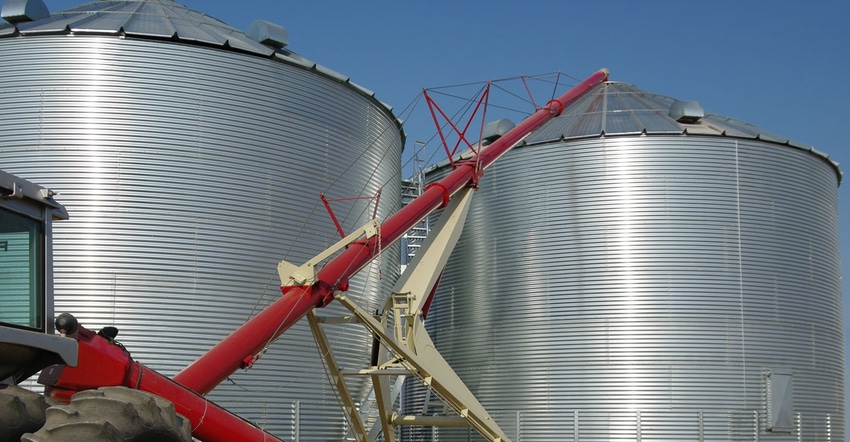March 1, 2019

By Lisa Jasa
After extended rains last fall, corn and soybeans may have been stored at a higher moisture content than usual. This moisture, along with the resulting molds, can lead to grain and particularly soybeans going out of condition and clogging or crusting in the bin.
It may be tempting to enter the bin to break the crust and facilitate grain movement, but it is unsafe and can be life-threatening.
On Feb. 9, a Nebraska City farmer and another man were loading their third truck of soybeans from a farm near Unadilla. When the flow of beans to the auger stopped, the farmer entered the grain bin to loosen the bridged beans.
He became trapped in the grain. and when he didn't respond to calls from outside the bin, rescue workers from three towns were called. They cut into the bin perimeter to empty the grain, but unfortunately, it was too late to save the farmer's life.
In less than a minute of becoming trapped, a person can become engulfed in grain and suffocate. An Extension article, Entrapment Risk Due to Flowing Grain, describes what happens: "When you are trapped by grain and exhale to breathe, the grain flows into the space created by the movement of your chest, placing pressure on your chest and reducing the space that your lungs have to expand during your next inhalation. Each time you exhale a breath, the space around your chest decreases ..."
Grain bin accidents can be prevented. Avoid risking your safety by learning about the dangers and taking precautions.
Entrapment concerns
Aaron Yoder, an associate professor at the University of Nebraska Medical Center, researches farm safety and conducts national farm safety programs.
Keeping grain in good condition is one of the first and most important steps in grain bin safety, he said. Storing wet grain, as was the case for many this year, can lead to molds and clogs.
Also, with fluctuating cold and then warm temperatures, grain freezes and thaws. As the grain cools, condensation builds up, and as it freezes, the ice can create bridges or clogs that will interfere with grain flow from the bin. Yoder encouraged farmers and farm workers to never enter a bin without a safety plan, including always having someone outside the bin to monitor their safety.
Yoder describes four scenarios often causing grain entrapment:
• Flowing grain. As an augur moves grain out from the bottom of the bin, a funnel forms in the center column of grain that can quickly pull down someone working on top of the grain to loosen it. Always have someone close monitoring the bin while you work, stay in communication with them, and establish emergency hand signals to communicate over equipment noise.
• Grain bridge collapse. Out-of-condition grain can crust over, and as grain shifts at the bottom of the bin, large air pockets can form underneath the bridge. While it can be tempting to break a bridge by tapping on it, when it gives way, your weight can quickly shift, causing you to fall into the space and be covered by grain. When possible, use a long rod from outside the bin to prod the crusted grain.
• Grain wall avalanche. Frozen or out-of-condition grain can cling to the bin's sidewalls and when prodded, flow to the bin floor. Don't underestimate the amount of grain involved and don't work where the grain wall is higher than you are. Wear a safety harness.
• Use of a grain vacuum. These tools can move several thousand bushels of grain in an hour. If a hose is dropped and becomes buried, flowing grain can shift and the surface can become unstable. You could be pulled under and carried toward the auger outlet.
Understand the hazards on your farm, think through the possible scenarios of what could happen, plan how to avoid them and, if necessary, how to respond.
Stay safe
Don't take shortcuts when working in enclosed spaces with grain. Take time to stay safe. Whenever possible, use inspection holes and grain bin level markers rather than entering the bin. If you have to enter the bin:
• Always wear a body harness that is securely attached to the outside of the grain bin.
• Never work alone. Tell others that you'll be entering the bin and always have a second person outside who can help.
• Establish a system of hand signals to communicate over the noise of operations.
• Never enter a bin while the auger is running. Lock off and tag the auger so someone doesn't turn it on while you're inside.
• Keep safety tools handy. Attach a long rod to the bin for prodding grain from a distance.
The Central States Center for Agricultural Safety and Health, located at the University of Nebraska Medical Center, will co-sponsor grain safety handling workshops for organizations in collaboration with the Grain Handling Safety Coalition, said Ellen Duysen, CS-CASH coordinator.
CS-CASH provides educational and marketing materials and food, and the Grain Safety Coalition provides the training. Here's how to apply for grain handling safety training for your community.
CS-CASH also can provide free grain safety speakers for presentations to ag organizations and communities.
Jasa is editor of CropWatch at University of Nebraska-Lincoln.
Source: UNL CropWatch, which is solely responsible for the information provided and is wholly owned by the source. Informa Business Media and all its subsidiaries are not responsible for any of the content contained in this information asset.
You May Also Like




